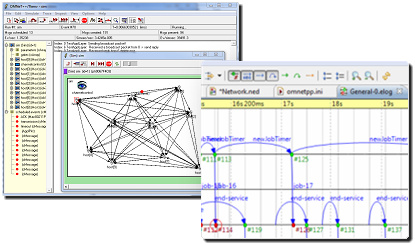
|
 |
Outline
|
OMNEST simulation software is used by R&D staff, researchers and engineers worldwide to investigate various scenarios and design alternatives: architectural designs, wireless/wired protocols and networks, queuing-based and other systems.
OMNEST lets you build and evaluate simulations in an Eclipse-based integrated Simulation IDE, and you can also embed simulations in your own software products. |
 |
Performance Modeling Estimate performance with queuing or resource allocation based models. |
|
 |
Architecture Verification Optimize your system's architecture with high-level simulations. |
|
 |
Network Simulation Design and evaluate wired, wireless, ad-hoc or sensor network protocols and networks. |
| IDE. Simulation models can be designed and evaluated in an Eclipse-based integrated Simulation IDE, and can be run utilizing various interfaces: from simple command-line interfaces that are ideally suited for batch execution, to sophisticated graphical animated user interfaces which can be used for debugging or demonstration purposes. You can also extend the IDE with software from the Eclipse Marketplace and other Eclipse plug-in sites. |
| Scalability, extensibility, SystemC, HLA. OMNEST simulations run very efficiently, due to the use of C++ and the careful design of the simulation library. Simulation models can also be executed using parallel distributed simulation, to speed up the simulations or to distribute memory requirements. Real-time execution and emulation (hardware-in-the-loop) are supported as well. The OMNEST-SystemC integration capability allows OMNEST simulations to directly incorporate parts written in SystemC, without loss of performance. OMNEST simulations can also participate in HLA federations. |
OMNEST (OMNeT++) Features
| * | very efficient OMNEST simulations execute fast and scale very well, which can be surprising given the amount of features in the simulation library |
| * | fast learning some C++ knowledge is required, but the programming model and the API can be picked up quickly, and one can become productive in a short time |
| * | great community OMNeT++ has a huge user community, and a lot of information is freely available on the Internet; this is very useful when one bumps into a problem, as the solution is often just a web search away (compare that with proprietary tools where publicly available information is often limited to marketing materials) |
| * | component model simulation models are easier to understand and maintain and can be combined in unexpected ways (because components do not interact with each other directly on the C++ level, only via means provided by OMNEST, e.g. messages) |
| * | not limiting the simulator and models can be extended in unforeseen ways; exotic scenarios such as interfacing with other simulators and external systems, parallel simulation, emulation, and combinations of the above, can be realized; and when something doesn't work as expected, the full source code is there to study and debug |
* The above content may change due to improvement without notice.